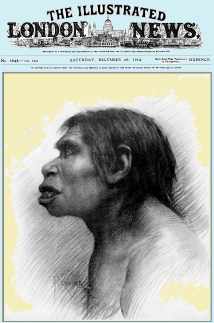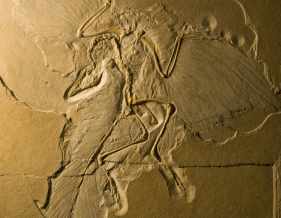©2002 by Gerard Wakefield http://www.creationism.org/wakefield/
http://www.creationism.org/wakefield/piltdownbird_en.htm Translated by:______
|
|
©2002 by Gerard Wakefield http://www.creationism.org/wakefield/ http://www.creationism.org/wakefield/piltdownbird_en.htm Translated by:______ |
Another Evolutionary Hoax In 1999, National Geographic published a photograph of a creature which "proved" that birds evolved from dinosaurs. Named Archaeoraptor, it was discovered in China and trumpeted as "a true missing link in the complex chain that connects dinosaurs to birds" (Sloan 100). The photograph displayed a creature "[w]ith arms of a primitive bird and the tail of a dinosaur" (Ibid.), accompanied by statements like, "It's a missing link between terrestrial dinosaurs and birds that could actually fly" (Ibid.), and "This fossil is perhaps the best evidence since Archaeopteryx that birds did, in fact, evolve from certain types of carnivorous dinosaurs [dromaeosaurs]" (Ibid. 101). |

Piltdown Man in 1912 |

Related Fossil: Archaeopteryx |
In the Letters to the Editor of the March 2000 issue, however, paleontologist Xu Xing (Chinese Academy of Sciences) wrote that "Archaeoraptor appears to be composed of a dromaeosaur tail and a bird body." When investigative reporter Lewis Simons delved into the hoax, he uncovered a tale of misguided secrecy and misplaced confidence, of rampant egos clashing, self-aggrandizement, wishful thinking, naive assumptions, human error, stubbornness, manipulation, backbiting, lying, corruption, and, most of all, abysmal communication (Simons 128). |
A Chinese farmer had glued two separate fossils together and sold "it" to a fossil dealer who "acknowledged that he often sold 'composites'" (Ibid. 129). It found its way to Stephen Czerkas, a dinosaur enthusiast with no scientific qualifications, who contacted paleontologist Philip Currie. Simons wrote, "Currie was so distracted by other commitments around the world that he gave the Archaeoraptor project short shrift" (Ibid. 130).
Currie had reservations about the fossil, but neglected to inform Christopher Sloan, who wrote the 1999 article. Simons called this "a most damaging lapse of responsibility" on Currie's part (Ibid.). The fossil was examined by Prof. Timothy Rowe of the University of Texas who stated, "[T]here was a chance that it was a fraud" (Ibid.). Currie sent a colleague, fossil technician Kevin Aulenback, to investigate; Aulenback concluded the fossil was "a composite specimen" (Ibid. 131).
Meanwhile, Czerkas and Currie submitted a paper on the fossil to the
journals Nature and Science. Simons describes the original
draft:
On its fifth page the paper stated that the dromaeosaur-like tail on a birdlike creature suggested a previously unknown element in the evolution of birds from landbound dinosaurs. In short, this was what Czerkas would tell National Geographic was "a missing link" (Ibid.).
Both journals rejected the article (Ibid.131-132). Nevertheless,
National Geographic went ahead and published its own version. Simons
called the ensuing media frenzy a "dog and pony show for reporters". (Ibid. 132).
|
... they saw what they wanted to see. |
Shortly thereafter Xu informed Sloan, "I am 100% sure...that Archaeoraptor is a faked specimen" (Ibid.). Once the fraud was exposed, Czerkas admitted he had made "an idiot, bone-stupid mistake." Currie said it was "the greatest mistake of my life." Sloan stated, "I was dragging in a monster" (Ibid.). National Geographic editor-in-chief William Allen asked, "How did we get into this mess?" (Ibid. 128). Simons offers an answer: "To some prominent paleontologists who saw it ... the little skeleton was a long-sought key to the mystery of evolution" (Ibid.). That is, they saw what they wanted to see.
Criticism has been harsh. In an article on the twenty greatest scientific
blunders in the past twenty years, Discover magazine listed "Piltdown
Chicken," its term for the fraud. The label derives from Piltdown Man,
an artificial composite of a human skull and an ape jaw "discovered" in
1912 (Newman 80). Just as earlier paleontologists embraced Piltdown Man
because they were dying for evidence of human evolution, contemporary scientists
embraced Archaeoraptor because of their desperation to prove that
birds evolved from dinosaurs.
References:
Newman, Judith. (2000). "Twenty of the Greatest Blunders in Science in the Last Twenty Years." Discover 21, no. 10.
Simons, Lewis (2000). "Archaeoraptor Fossil Trail." National Geographic 198, no. 4.
Sloan, Christopher (1999). "Feathers for T. Rex?" National Geographic
196, no. 5.
|
|
|